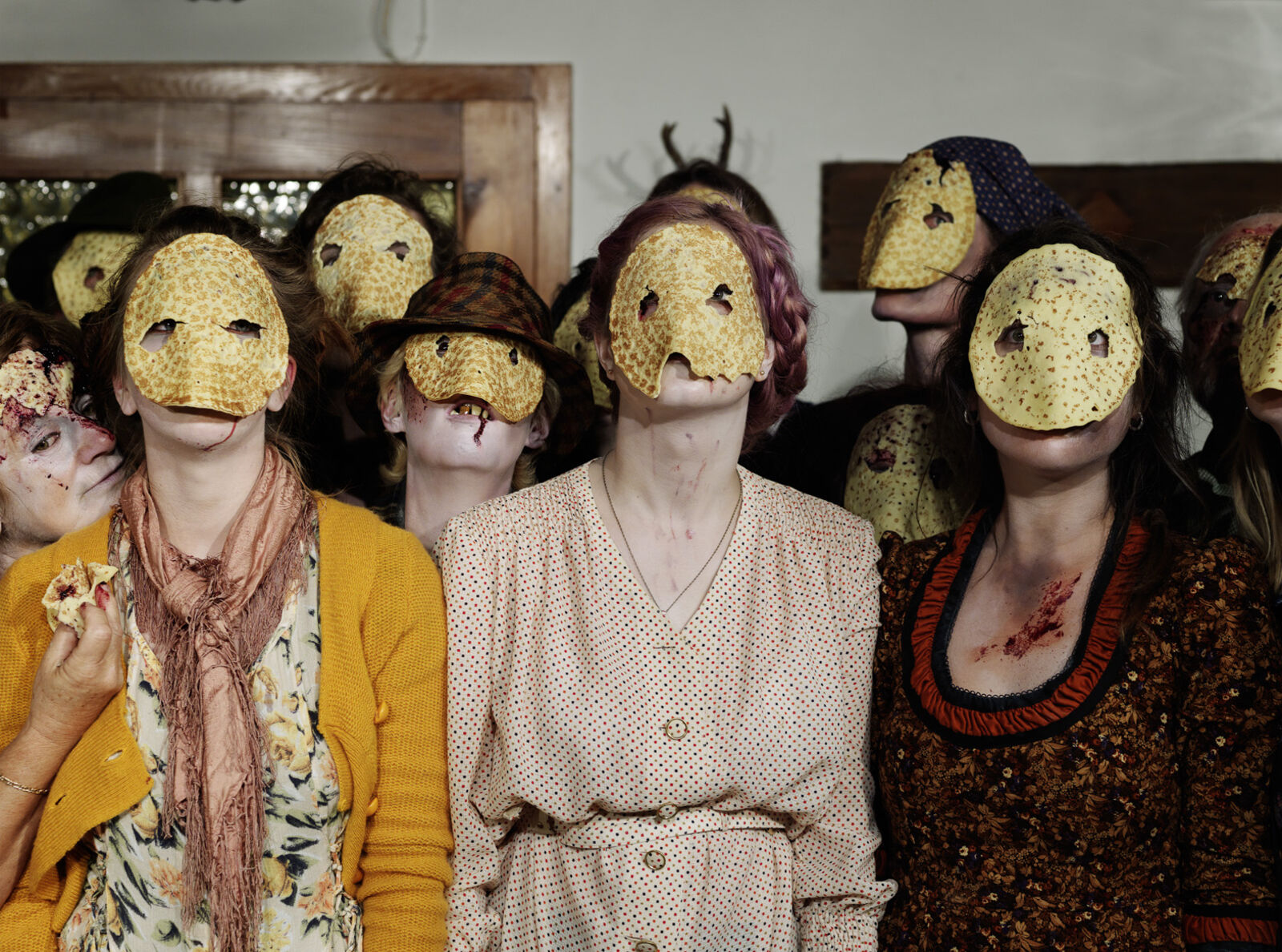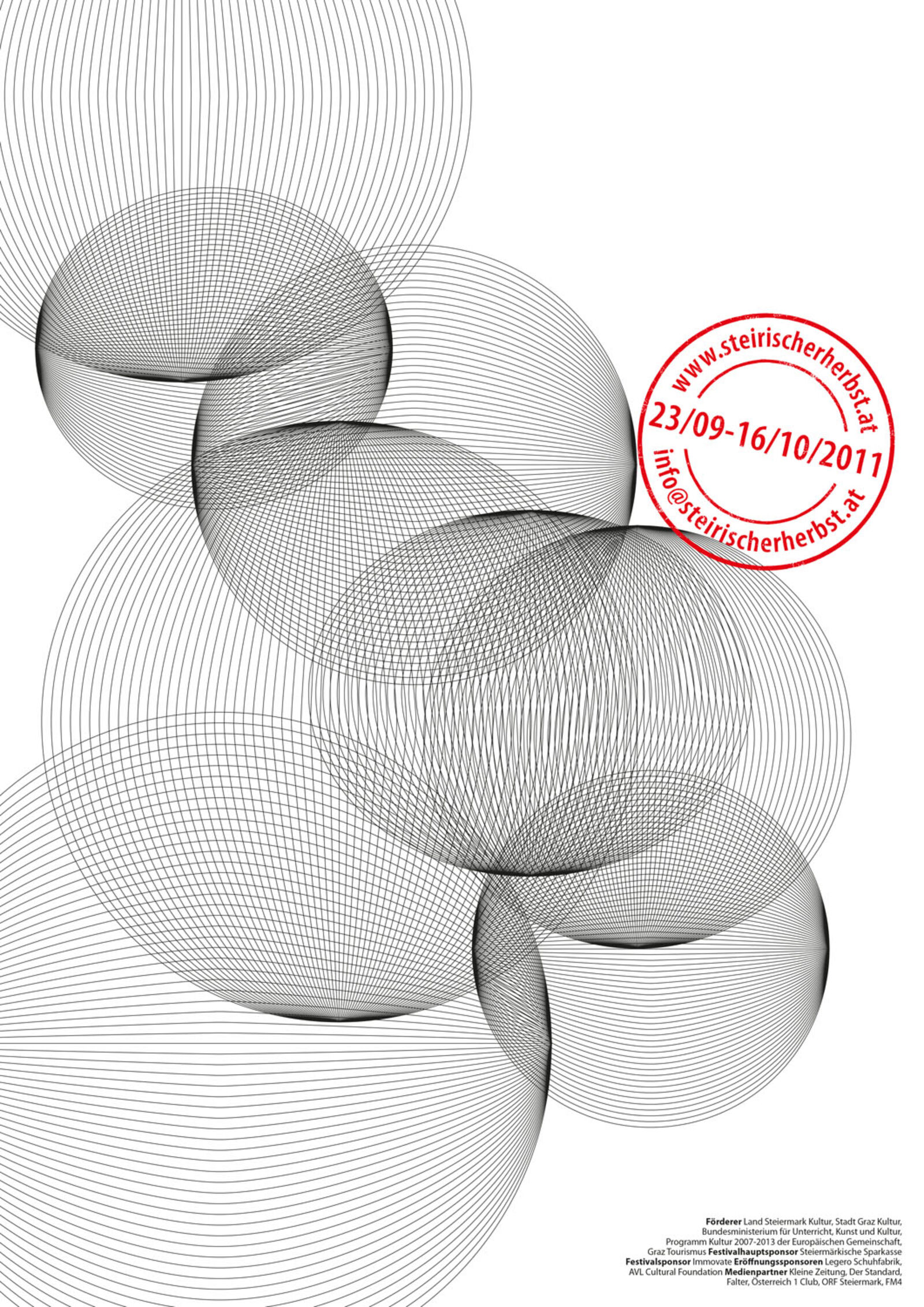Veronica Kaup-Hasler

Mette Ingvartsen, to come (extended) (2017), performance, Helmut List Halle, Graz, 2017, photo: Wolfang Silveri

Apichatpong Weerasethakul, Fever Room (2015), projection performance, Orpheum, Graz, 2016, photo: Chai Siris; courtesy of the artist

Kooperative für Darstellungspolitik, Pavillon (2009), scaffolding, wooden beam structure, printed formwork panels, at Utopie und Monument I, Platz der freiwilligen Schützen, Graz, 2009, photo: Wolfgang Silveri

Hannah Hurtzig / Mobile Akademie, Schwarzmarkt für nützliches Wissen und Nicht-Wissen Nr. 8 (2007), installation and performance, Orpheum, Graz, 2007, photo: Johannes Gellner

Kader Attia, The Myth of Order (2010), video still, at Utopie und Monument II, courtesy of Kader Attia; © Bildrecht, Wien 2021

Marusa Sagadin, Festivaldistrikt (2011), Festival Center of steirischer herbst ’11, Mariahilferstraße, Graz, 2011, photo: Wolfgang Silveri

Nature Theater of Oklahoma, Life and Times, Episodes 4.5 & 5 (2013) and Episode 6 (2014), plays, with Ilan Bachrach (middle), MUMUTH, Graz, 2014, photo: Wolfgang Silveri; courtesy of the artists

atelier le balto, Ex-Zollamt (2013), Festival Center des steirischen herbst ’13, Ex-Zollamt, Graz, 2013, photo: Ph. Winkelmeier

Nature Theater of Oklahoma, Die Kinder der Toten von Elfriede Jelinek (2017), performance and film, Neuburg an der Mürz, Mürzzuschlag, 2017, photo: Ditz Fejer

General Assembly, discussion, facilitated by Hector Huerga, at Truth Is Concrete, The Camp, Graz, 2012, photo: Wolfgang Silveri
2006–2017
In late September 2004 the German-Austrian dramaturge and festival curator Veronica Kaup-Hasler was appointed artistic director of steirischer herbst, which she directed from 2006 to 2017. This was the first time that a recognized theater and performance expert was director, a choice that also affected the structure of steirischer herbst and its identification as a multidisciplinary festival with a focus on innovative theater productions. This was particularly evident due to the creation of a dramaturgy department, which was independently responsible for designing the many festival formats. Along with Kaup-Hasler, Florian Malzacher also came on board in 2006 as head dramaturge and curator, staying until 2012. He was joined in 2007 by the dramaturge Kira Kirsch, who was head dramaturge and curator from 2013 to 2015, and Reinhard Braun as the curator for visual art, who stayed until 2010. This position was subsequently held by Luigi Fassi from 2013 to 2017. Martin Baasch was head dramaturge and curator from 2015 to 2017.
An advisory arts committee—consisting of Hannah Hurtzig, Berno Odo Polzer, Goran Sergeij Pristaš, Georg Schöllhammer, and Gesa Ziemer, and supplemented as of 2009 by Cosmin Costinas and Diedrich Diederichsen—continued to exist until 2012. The managing directors were Richard Schweitzer (2006–08), Martin Walitza (2009), Artemis Vakianis (2010–13), Floridus Kaiser (2014–15), and Agnes Wiesbauer (2016–17).
Kaup-Hasler and her team intensified the interdisciplinary character of the festival with numerous new discursive series and individual formats as well as a thematic focus linking the various areas. A concentration of the individual sections of the festival was also achieved by shortening the festival duration to four weeks. Hardly any of the many international premieres and first performances in the areas of theater, dance, and performance that were characteristic under Kaup-Hasler were conventional theater productions. There was a particular focus on joint productions with other international theater festivals and guest performances that could be seen for the first time in the German-speaking world. These performances were for the most part presented at one of the theaters in Graz (Orpheum, Dom im Berg, and Kasemattenbühne) that were rented for the festival.
Visual art was also incorporated thematically to a greater extent—for the first time there was an independent herbst exhibition, each organized by an external curator. Exhibitions by private galleries or museum exhibitions that were not related to the festival theme were henceforth no longer included in the program. Instead, there were strategies to let the local scene participate in the festival through exhibitions that fit into the edition’s leitmotif.
Starting in 2006, the festival activities with workshops and the annual herbst Bar, which was reinitiated in 2009, were concentrated in a festival center that resulted from an architectural and artistic intervention by young architecture firms at a different public location each year. In 2006, Stephen Craig redesigned the Künstlerhaus im Stadtpark especially for the festival, in 2007 an independent temporary theater was erected on Karmeliterplatz, and in 2008 the festival center moved to the vacant Joanneum. The official openings took place (with the exception of 2012) at the Helmut List Halle.
The leitmotifs of the program—some concrete, others more ambiguous—included Kontrolle, Kollaboration, Teilhabe und offene Quellen (Control, Collaboration, Participation, and Open Sources, 2006), Nahe genug (Close Enough, 2007), Strategien zur Unglücksvermeidung (Strategies for Avoiding Misfortune, 2008), All the Same (2009), Truth Is Concrete(2012), Liaisons dangereuses: Alliancen, Mesalliancen und falsche Freunde (Liaisons dangereuses: Alliances, Misalliances, and False Friends, 2013), I Prefer Not to … Share! (2014), or Where Are We Now? (2017). Though the program booklet retained the subdivision into the genres of visual and performing arts, music and theory, the interdisciplinary orientation of all the events in steirischer herbst was highlighted graphically with rubber stamps that playfully noted the respective ingredients in percentages—for instance “63% theater, 37% literature” or “33% activism, 33% theory, 33% art.”
The new discursive formats included the herbst Academy—consisting of workshops and a herbstCamp—which involved festival participants for an extended period of time. As a supplement to the program booklet, an independent magazine called herbst: Theorie zur Praxis was first published in 2006, in which festival protagonists and other authors addressed the respective themes in greater depth. Other theory formats were the series of open lectures and discussions called Open Ups, performative conferences such as Wörterbuch des Krieges (War Dictionary; idea and concept: Unfriendly Takeover / Multitude e. V.) in 2006, and Spielfeldforschung (Playing-Field Research; idea and concept: Gesa Ziemer), the theoretical backbone of the festival, dedicated to in-depth examinations parallel to the program—as Kaup-Hasler noted, “not academic science approaching art as an object, but rather a strolling, aimless way of exposing oneself to art.” Starting in 2006, the festival also published the virtual literary journal Randnotizen (Marginal Notes), for which participants from literature, visual art, and web discourse served as writers-in-residence, scribes, and observers. From 2009 to 2017, the program at the festival center was accompanied by the video documentation herbst remixed.
The only autonomous series from the existing steirischer herbst program to be continued was musikprotokoll, which had been organized by the Austrian broadcaster ORF. It became independent during this time as an autonomous “festival within the festival,” and it continues to exist as such to this day. For the openings, however, steirischer herbst and musikprotokoll often developed productions that went beyond the scope of the music festival. The Music Symposium, Mürz Werkstatt, Deutschlandberg youth music festival, and K.U.L.M. ended when Peter Oswald stepped down as artistic director.
Productions in the categories of theater, dance, and performance—including many commissioned works and collaborations—particularly attracted international attention, with interdisciplinary troupes and individuals from all over the world such as Lone Twin (2006), Nature Theater of Oklahoma (2007, 2008, 2014, 2017), Lola Arias (2007, 2009, 2010), Tim Etchells (2006, 2007), Rimini Protokoll (2009, 2015), Forced Entertainment (2009), Gisèle Vienne (2008, 2010), Anne Teresa De Keersmaeker (2011, 2015), Young Jean Lee (2012, 2014), Needcompany (2014), and Rabih Mroué (2012, 2017). During the twelve years under Kaup-Hasler as artistic director, steirischer herbst managed to strengthen its position outside of Graz and broaden its international scope: in 2007, the festival became part of NXTSTP, a cultural network supported by the European Union.
Exhibition highlights included the project Utopie und Monument (Utopia and Monument, 2009 and 2010), which was curated by Sabine Breitwieser and divided up over two years, for which international contemporary artists such as Lara Almarcegui, Kader Attia, Nairy Baghramian, Ayşe Erkmen, Isa Genzken, John Knight, and Andreas Siekmann created works in public space connected with the controversial terms in the title. In addition, steirischer herbst increasingly brought visual art to surrounding Styria, for example with Ulla von Brandenburg’s Wolken lösen sich in Wasser (Clouds Dissolve in Water) at Porubsky-Halle Leoben.
In 2012, steirischer herbst reacted to the rapid changes, crises, and upheavals around the globe that gave rise to movements such as the Arab Spring or Occupy, with the “24/7 marathon camp” Truth Is Concrete (curated by Anne Faucheret, Veronica Kaup-Hasler, Kira Kirsch, and Florian Malzacher; idea and concept: Florian Malzacher). More than two hundred artists, scholars, and activists—including the Colombian philosopher and politician Antanas Mockus, the theorist Chantal Mouffe, and the radical Russian artist group Voina—analyzed artistic strategies in politics and political strategies in art around the clock for one week. The Camp am Opernring, which consisted of various work and habitation modules, a library, and an exhibition space, was designed by raumlaborberlin. This event, which was unique within the scope of steirischer herbst, was accompanied by a separate program booklet and, in 2014, the publication Truth Is Concrete: A Handbook for Artistic Strategies in Real Politics.
In 2017, steirischer herbst celebrated the fiftieth anniversary of its establishment. It was also the final year under Veronica Kaup-Hasler. Die Kinder der Toten (The Children of the Dead, 2017), the four-week performance and first film adaptation of Elfriede Jelinek’s eponymous novel at the original locations in and around Neuberg an der Mürz with members of the Nature Theater of Oklahoma, was certainly one of the most complex productions of her term as artistic director. It premiered at the Berlin International Film Festival, where it won the FIPRESCI award in 2019, and was subsequently shown at over sixty international film festivals.
Bio
Veronica Kaup-Hasler
(1968, Dresden, Germany)
Dramaturge and culture manager
Studied theater studies and German
1993–95 Dramaturge at Theater Basel
1995–2001 Festival dramaturge at Wiener Festwochen
2001–2004 Director of the biannual Festival Theaterformen
2006–2017 Director and Chief Executive of steirischer herbst
2018– City Councillor for Arts and Science, Vienna
Teaching
1998–2001 Lecturer at the Academy of Fine Arts Vienna
Paris Lodron Universität Salzburg, Ludwig-Maximilian-Universität München (Curation in the Performing Arts program), Leibniz University Hanover, Technische Universität Braunschweig, Universität Hamburg
Publications (selection)
Ed. with Florian Malzacher et al.: Truth Is Concrete: A Handbook for Artistic Strategies in Real Politics. Berlin: Sternberg, 2014.
Ed. with Christiane Kühl et al.: Where Are We Now? Positionen zum hier und jetzt: Positions on the Here and Now. Berlin: The Green Box, 2017.
Festival editions
Retrospective
Retrospective











